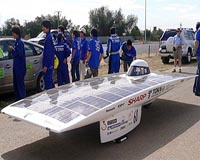 |
Moffett Field CA (SPX) Oct 29, 2009 NASA has announced under the terms of two Space Act Agreements, it will partner with MSGI Security Solutions Inc., San Francisco, to advance solar cell technology and develop nano-chemical sensors. The solar cells will use semiconductor materials instead of silicon crystals and prepare them in a nanostructured form for greater efficiency. NASA and MSGI also will use nanotechnology and carbon-based chemical sensing to detect gas and organic vapors found in human breath. NASA developed these two revolutionary nanotechnologies that now have promising alternative applications. Solar cells that powered space missions now may compete with conventional electricity as an energy source. An electronic sniffing sensor, used to monitor the air onboard the space shuttle, may be used for medical diagnoses and environmental monitoring. "Silicon crystalline solar technology has limitations that this new nanostructured form and semiconductor technology will surpass," said Meyya Meyyappan, chief scientist for exploration technology and director of the Center for Nanotechnology at NASA's Ames Research Center, Moffett Field, Calif. "This has led NASA to investigate novel materials, substrates and production techniques with the goal of becoming more efficient while achieving lower production costs." MSGI recently announced that its subsidiary companies will co-develop and commercialize these technologies. Andromeda Energy Inc., will focus on scalable renewable energy solutions that cost less per watt than conventional energy sources. "We are committed to establishing a solar platform in Northern California, which will create new jobs and help stimulate the local economy, while reducing our dependence on traditional energy sources," said Jeremy Barbera, chairman and chief executive officer of MSGI Security Solutions, Inc. Nanobeak Inc., is a nanotechnology company that develops carbon nanotube-based chemical sensing devices. It will soon launch its first prototype, derived from NASA technology, which is a handheld sensor that can detect diabetes. The device will measure specific signatures for diabetes by simply breathing into a personal handheld device. This will help eliminate expensive laboratory tests and inconvenient trips to the laboratory facility. "This product will provide a simple, non-invasive test to save lives by providing early diabetes detection," said Barbera. "More than fifty percent of all people who have diabetes are unaware of that fact." Share This Article With Planet Earth
Related Links NASA's Innovative Partnership Program MSGI Solutions All About Solar Energy at SolarDaily.com
 Japanese car wins World Solar Challenge in Australia
Japanese car wins World Solar Challenge in AustraliaSydney (AFP) Oct 28, 2009 A Japanese sun-powered car won the World Solar Challenge on Wednesday after averaging speeds of more than 100 kilometres (62 miles) per hour in a four-day race through Australia's desert Outback. Organisers said the Tokai Challenger crossed the finish line in Adelaide, South Australia, at 3:39 pm local time, after 29 hours and 49 minutes' racing following Sunday's departure from the northern ... read more |
|
| The content herein, unless otherwise known to be public domain, are Copyright 1995-2009 - SpaceDaily. AFP and UPI Wire Stories are copyright Agence France-Presse and United Press International. ESA Portal Reports are copyright European Space Agency. All NASA sourced material is public domain. Additional copyrights may apply in whole or part to other bona fide parties. Advertising does not imply endorsement,agreement or approval of any opinions, statements or information provided by SpaceDaily on any Web page published or hosted by SpaceDaily. Privacy Statement |